Tuesday, December 19, 2006
Monday, September 18, 2006
 The view of Aberystwyth from the top of Constitution Hill hasn't changed a great deal over the years but the town itself certainly has. The tension between town and gown and the influx of young people getting drunk and brawling in the streets are still there but there is now a vibrancy about the place; hotels and guest houses along the promenade have a fresh coat of paint and new shops and restaurants have mushroomed. The Orendy (Orangery), for example, is quite a chic wine bar and Le Figaro is well worth a visit.
The view of Aberystwyth from the top of Constitution Hill hasn't changed a great deal over the years but the town itself certainly has. The tension between town and gown and the influx of young people getting drunk and brawling in the streets are still there but there is now a vibrancy about the place; hotels and guest houses along the promenade have a fresh coat of paint and new shops and restaurants have mushroomed. The Orendy (Orangery), for example, is quite a chic wine bar and Le Figaro is well worth a visit.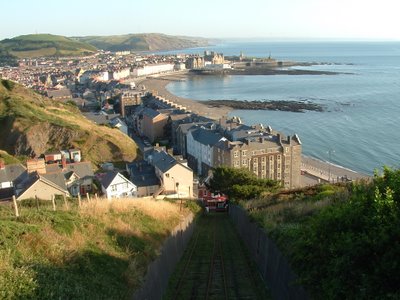 The funicular railway wasn't working when we visited but the walk up the hill isn't particularly taxing. I have been unable to find out why the hill is called Constitution Hill. Was it called after a particular 'Constitution' or was it regarded perhaps as just a good walk?
The funicular railway wasn't working when we visited but the walk up the hill isn't particularly taxing. I have been unable to find out why the hill is called Constitution Hill. Was it called after a particular 'Constitution' or was it regarded perhaps as just a good walk?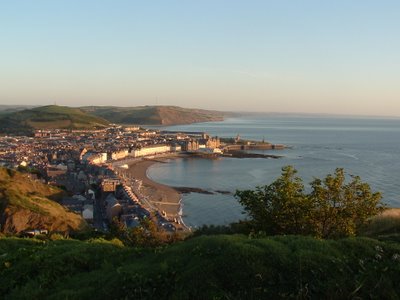 Looking across Cardigan Bay as the sun set I could just make out Bardsey and the hills of the Llyn peninsula where I was born and bred. It brought back memories of Mynytho and of clear anticyclonic nights when the lights of Aberystwyth and most of the other coastal towns could be seen twinkling across the bay.
Looking across Cardigan Bay as the sun set I could just make out Bardsey and the hills of the Llyn peninsula where I was born and bred. It brought back memories of Mynytho and of clear anticyclonic nights when the lights of Aberystwyth and most of the other coastal towns could be seen twinkling across the bay.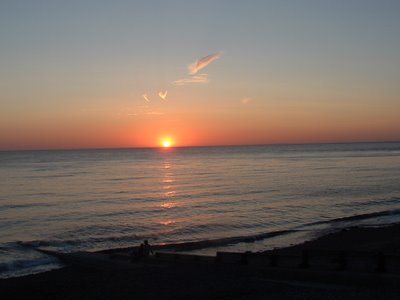 The A4120 from Aberystwyth follows the river Rheidol and there are magnificent views of the valley to be had. A stop at Pontarfynach (Devil's Bridge) where the river Mynach has gouged out a deep chasm in its journey to the Rheidol is essential. Legend has it that a monk from nearby Ystrad Fflur fell to his death in attempting to cross it and that when the devil offered to build a bridge for the price of the soul of the first to use it the local people accepted the terms. The devil obviously didn't know that Cardiganshire folk are renowned for their frugality, even in the matter of souls, and on completing the bridge couldn't have been best pleased to find that the soul that he recieved was that of a dog enticed across the bridge by a thrown morsel. Over the years two more bridges have been built on top of the original and for a toll one can climb down steps and view the three bridges straddling each other with the river hurtling underneath.This being Cardiganshire, there are two tolls, one on each side of the bridge! The one on the east side is the cheapest and probably where the best photographs of the bridges can be taken but the one on the west side is the most picturesque. Steps, rather precipitous at times, meander down through native hardwoods until on reaching the lowest point one crosses
The A4120 from Aberystwyth follows the river Rheidol and there are magnificent views of the valley to be had. A stop at Pontarfynach (Devil's Bridge) where the river Mynach has gouged out a deep chasm in its journey to the Rheidol is essential. Legend has it that a monk from nearby Ystrad Fflur fell to his death in attempting to cross it and that when the devil offered to build a bridge for the price of the soul of the first to use it the local people accepted the terms. The devil obviously didn't know that Cardiganshire folk are renowned for their frugality, even in the matter of souls, and on completing the bridge couldn't have been best pleased to find that the soul that he recieved was that of a dog enticed across the bridge by a thrown morsel. Over the years two more bridges have been built on top of the original and for a toll one can climb down steps and view the three bridges straddling each other with the river hurtling underneath.This being Cardiganshire, there are two tolls, one on each side of the bridge! The one on the east side is the cheapest and probably where the best photographs of the bridges can be taken but the one on the west side is the most picturesque. Steps, rather precipitous at times, meander down through native hardwoods until on reaching the lowest point one crosses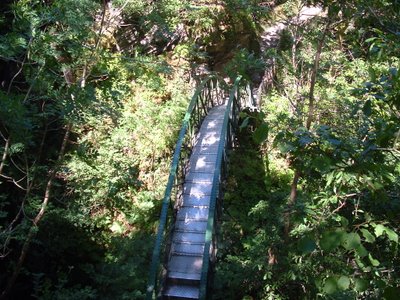 the river Mynach by a beautiful semicircular Victorian iron work bridge. There is, of course, the climb back up but one is rewarded with fine views of the falls and, opposite the exit gate, the welcome sight of the Hafod Arms Hotel where I enjoyed a good pint of real ale before taking the brief journey to Ystrad Fflur (Strata Florida Abbey). On the day we visited there was an art exhibition in the grounds and one of the most startling exhibit was a 'picnic', beautifully set out on three tables. All the food, plates, etc, however, were moulded from metal!
the river Mynach by a beautiful semicircular Victorian iron work bridge. There is, of course, the climb back up but one is rewarded with fine views of the falls and, opposite the exit gate, the welcome sight of the Hafod Arms Hotel where I enjoyed a good pint of real ale before taking the brief journey to Ystrad Fflur (Strata Florida Abbey). On the day we visited there was an art exhibition in the grounds and one of the most startling exhibit was a 'picnic', beautifully set out on three tables. All the food, plates, etc, however, were moulded from metal!
We were amused but not impressed by the exhibition as a whole but grateful that the entrance fee to the site had been waived. Who said the Cardis were tight!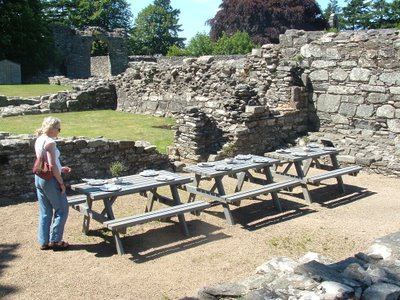 I wanted to go to Ystrad Fflur to pay my repects to the one of the world's greatest poets, Dafydd ap Gwilym. It is tragic that Welsh poetry written in the traditional measures is virtually untranslateable or Dafydd's name would slip off the tongue as easily as Dante's or Shakespeare's.
I wanted to go to Ystrad Fflur to pay my repects to the one of the world's greatest poets, Dafydd ap Gwilym. It is tragic that Welsh poetry written in the traditional measures is virtually untranslateable or Dafydd's name would slip off the tongue as easily as Dante's or Shakespeare's.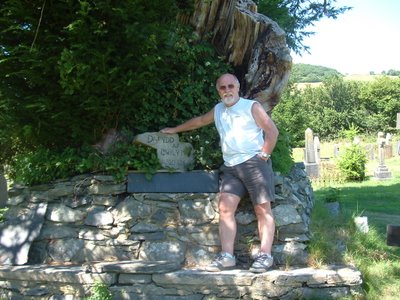 It is believed that he died in 1380 and whether he was really buried in Ystrad Fflur is also a matter of conjecture but, nonetheless, I believe that he deserves far more from a supposedly poet venerating nation than a pathetic sign under an yew tree and an inscribed slate on the crumbling wall of a 12th century ruin. Perhaps I've been living in the land of Shakespeare for too long!
It is believed that he died in 1380 and whether he was really buried in Ystrad Fflur is also a matter of conjecture but, nonetheless, I believe that he deserves far more from a supposedly poet venerating nation than a pathetic sign under an yew tree and an inscribed slate on the crumbling wall of a 12th century ruin. Perhaps I've been living in the land of Shakespeare for too long!
Another relic, but far older, can be seen near Nevern at the foot of the Preseli mountains. This is the Pentre Ifan burial chamber built about 3500 BC. The capstone is made from the same type of stone as that which makes parts of Stonehenge and is estimated to weigh over 16 tons!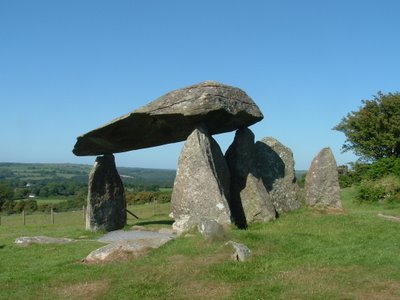 Abergwaun (Fishguard) is quite close and a stay at the Fishguard Bay Hotel in nearby Goodwick is worthwhile. The food is excellent and the view from our bedroom window, ignoring the flat roof and the car park for the Irish ferry was quite beautiful.
Abergwaun (Fishguard) is quite close and a stay at the Fishguard Bay Hotel in nearby Goodwick is worthwhile. The food is excellent and the view from our bedroom window, ignoring the flat roof and the car park for the Irish ferry was quite beautiful.
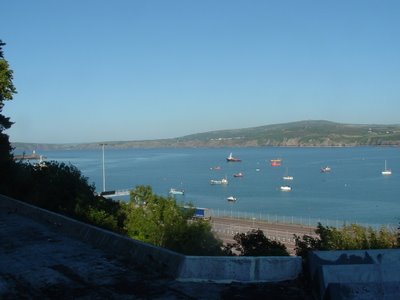
Taking minor roads along the coast towards St David's, we visited Carregwasted point near Llanwnda. This is where the last invasion of Britain took place in 1797. The invaders were the French and legend has it that they mistook the local women dressed in their tall black hats and red shawls for British Redcoats and surrendered. There had been another successful invasion from France in 1485 led by Henry Tudor who landed in Pembrokeshire on his way to being crowned King of England. The Tudor dynasty that he founded was not particularly sympathetic to Wales and her people and I've often thought what would have happened to our country if the 'invasion' of 1797 had succeeded.
A few miles down the coastline is Pwllderi where there is a memorial stone to another Welsh poet, Dewi Emrys (1891-1952), who has never achieved the recognition that he deserves. Unfortunately, though being a minister with the Independents, his bohemian life did not endear him to the Welsh poetic establishment. That he also wrote poetry in English ('Rhymes of the Road', Cecil Palmer, London, 1928) wouldn't have been in his favour. All of these characteristics were, if not acceptable, later tolerated in an Anglo-Welsh poet like Dylan Thomas!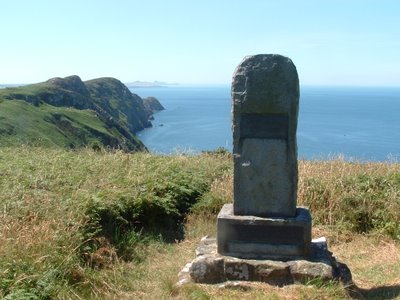
Between Abercastell and Trefin is another burial chamber called Carreg Samson (Samson's Stone). It stands in a field overlooking the sea belonging to the Longhouse Farm. Originally, like the one at Pentre Ifan, it would have been covered by stones and earth to appear like a large mound. The cows now use the stone skeleton as a shelter from the sun.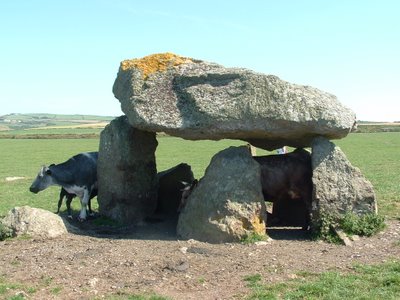 We, to get out of the sun, paid a visit to the 'Farmers Arms' at Brynamlwg near Mathry. The crab sandwiches were unavailable and we had some succulent ham ones instead accompanied by wine and one of Brains' bitters. A beautiful Welsh sheepdog sat under the stool of his owner at the bar and I swore blind that he counted every piece that we ate. His name was Waldo! I hoped that his name was in honour of Waldo Williams who was another wonderful poet from Pembrokeshire: a conscientious objector, pacifist and a Welsh nationalist who spent time in prison for his beliefs. Not surprisingly, like Dewi Emrys, he was not part of the literary establishment of Wales. There is a memorial cairn for him in Rhos-Fach near Mynachlog Ddu, not very far from the Pentre Ifan burial chamber.
We, to get out of the sun, paid a visit to the 'Farmers Arms' at Brynamlwg near Mathry. The crab sandwiches were unavailable and we had some succulent ham ones instead accompanied by wine and one of Brains' bitters. A beautiful Welsh sheepdog sat under the stool of his owner at the bar and I swore blind that he counted every piece that we ate. His name was Waldo! I hoped that his name was in honour of Waldo Williams who was another wonderful poet from Pembrokeshire: a conscientious objector, pacifist and a Welsh nationalist who spent time in prison for his beliefs. Not surprisingly, like Dewi Emrys, he was not part of the literary establishment of Wales. There is a memorial cairn for him in Rhos-Fach near Mynachlog Ddu, not very far from the Pentre Ifan burial chamber.
Another poet who has become associated with Pembrokeshire, though born in Glamorgan, is Crwys (William Williams). Crwys was an establishment figure and was Archdruid from 1939 -1947. He wrote a famous poem about the mill in Trefin where the wheat of Llanrhian was brought to be ground. Both Trefin and Llanrhian are on the route to Porthgain, an old slate and granite port. The bins that held different sizes of granite can still be seen on the edge of the quay.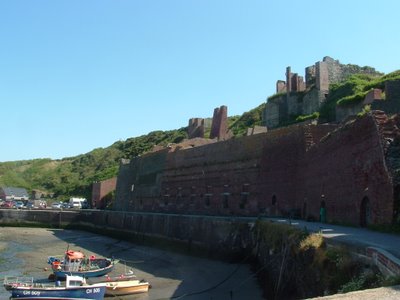
The 'Sloop Inn' in Porthgain is in the Good Pub Guide but since we had just been to the Farmer's Arms we gave it a miss. We were very impressed with the Harbour Lights Gallery where the curator was extremely informative and helpful. Some of Gillian Mcdonald's work was on display and we much admired it.
Unlike most other cathedral cities entering Tyddewi (St David's) is a non-event. The city is tiny, less than 1500 population, but more importantly the cathedral cannot be seen until one is right on top of it: it is in a hollow! But the view from The Pebbles at sunset of the golden stonework of the cathedral and ruins of the Bishop's Palace is breathtaking. The inside has many wonderful architectural features including fine wood work and, though I am an aetheist, I remember being particularly moved on being there many years ago when the organist was rehearsing and playing Bach's Toccata and Fugue in D Minor.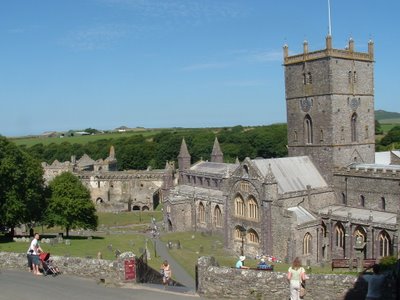
But the edifice is a symbol of institutionalised power and the tomb of Edmund Tudor the son of Owain Tudur and father of Henry VII underlines this for me. Owain reputedly was at the battle of Agincourt and became a minor figure in the court of the late Henry V. He became the lover of Katherine de Valois (Henry V's widow) and eventually married her. Thus a Welsh commoner became a powerful figure in the English court and begat a dynasty that did his nation no favours. It is interesting to note that Owain Tudur's father was related to Owain Glyndwr who rebelled against English tyranny!
We stayed at The Grove Hotel, opposite the rather grand new Visitor Centre, and found it to be very friendly and serving good food. One evening we were in the Old Cross Hotel and witnessed the reaction of a person being given a £3,300 bill for his and his wife's bar meals! The barman quickly realised that he'd somehow keyed the data without decimal points and that it should only have been £33. I can thoroughly recommend the curry, by the way, and am pleased to be able to say that it only cost £5.99!
Pembrokeshire has many magnificent beaches, none better than Porth-mawr (Whitesands Bay) lying a couple of kilometres to the north-west of Tyddewi. To the north can be seen the hulk of Carn Llidi (181 m) which is a spitting image of Holyhead Mountain in Anglesey which is not surprising since both share the same geological history.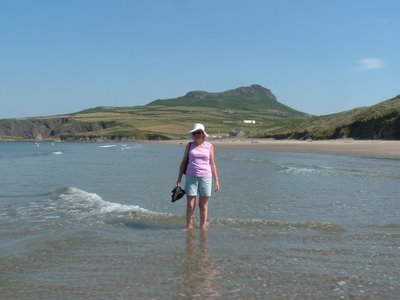
An excellent way to view the gelogical features and associated landforms is to take a cruise along the coast and around some of the islands. One can clearly see evidence of land building forces as in a huge crack that runs parallel to the edge of a sea cave and wonder how long it will take before the cave trebles its size.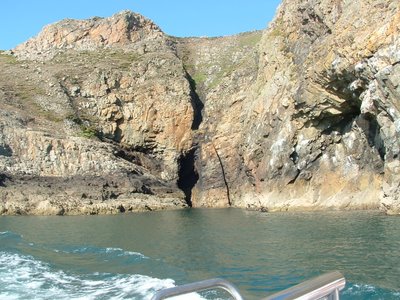 Ramsey Island has been managed by the RSPB since 1992 and landing on the island is restricted to one boat company that operates from St Justinian's, three kilometres west of Tyddewi. Incidentally, Justinian (Iestyn in Welsh) was a friend of St David and settled down to live a life of an hermit on Ramsey Island back in the sixth century. It is well worth landing there and spending some time walking the designated paths which afford some stunning views.
Ramsey Island has been managed by the RSPB since 1992 and landing on the island is restricted to one boat company that operates from St Justinian's, three kilometres west of Tyddewi. Incidentally, Justinian (Iestyn in Welsh) was a friend of St David and settled down to live a life of an hermit on Ramsey Island back in the sixth century. It is well worth landing there and spending some time walking the designated paths which afford some stunning views.
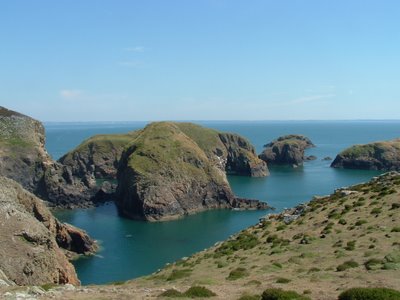 The island is used by tens of thousands of birds as a home or resting place and the steep cliffs provide nesting places for guillemots, razorbills and fulmars among many others. When we visited we failed to see the wild deer but the choughs were very evident as well as endangered lapwings.
The island is used by tens of thousands of birds as a home or resting place and the steep cliffs provide nesting places for guillemots, razorbills and fulmars among many others. When we visited we failed to see the wild deer but the choughs were very evident as well as endangered lapwings.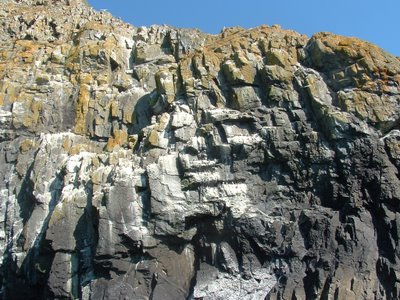 On our trip round the island we also saw some Atlantic grey seals and a school of porpoises. On a placid summer's day it is certainly a magical area but one can also imagine winter with storm driven waves of the Irish Sea battering the cliffs. No wonder the birds adopt predominantly south and south-east facing cliffs to roost and cover in guano.
On our trip round the island we also saw some Atlantic grey seals and a school of porpoises. On a placid summer's day it is certainly a magical area but one can also imagine winter with storm driven waves of the Irish Sea battering the cliffs. No wonder the birds adopt predominantly south and south-east facing cliffs to roost and cover in guano.
About six kilometres east of Tyddewi is Solva. The lower village, which is the most interesting, lies in a deep valley at the head of a natural harbour which was formed by a glaciated valley inundated by a rising sea level (a ria in geological terminology). In many ways it is a miniature Milford Haven which is further down the coast. Solva woollen mill is worth visiting but a crab sandwich and a pint of real ale at the Harbour Inn is a must. It is a great shame that a car park stands between the outside tables and the harbour.
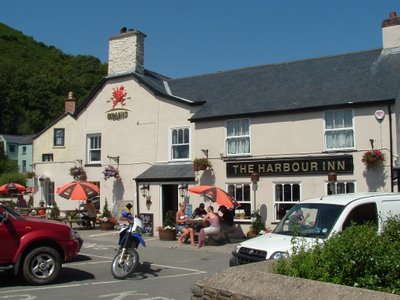 Looking south from upper Solva one sees the sweep of St Bride's Bay and the island of Skomer at its extremity. At the south end of the bay lies Little Haven which once was a small coal port but now like most places north of Milford Haven is dependent on the tourist industry. We had a wonderful meal at The Nest Bistro and stayed at the Clock House, a very friendly B & B in Marloes. It is only a short drive to Martin's Haven where there is a National Trust car park and the start of a wonderful walk round Wooltrack Point, the end of the peninsula overlooking Skomer.
Looking south from upper Solva one sees the sweep of St Bride's Bay and the island of Skomer at its extremity. At the south end of the bay lies Little Haven which once was a small coal port but now like most places north of Milford Haven is dependent on the tourist industry. We had a wonderful meal at The Nest Bistro and stayed at the Clock House, a very friendly B & B in Marloes. It is only a short drive to Martin's Haven where there is a National Trust car park and the start of a wonderful walk round Wooltrack Point, the end of the peninsula overlooking Skomer.
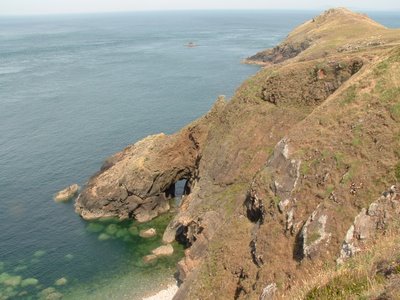 Our next stop was at Lamphey palace establishe in the thirteenth century as the country retreat for the bishops of St David's. It is somewhat incredible today to think of someone like the no doubt hardworking Bishop Henry de Gower finding it difficult to endure the strains and stresses of fourteenth century ecclestiastical life in the smallest cathedral in Britain. But he was a member of the aristocracy, as his Norman name suggests, and retreating here to Lamphey to live the life of a country gentleman amongst other members of his class who over the years had been granted land in this part of Wales would probably be more important and pleasant than dealing with matters of the Church. This part of Pembrokeshire is not unsurprisingly called 'little England beyond Wales' and its castles, fortified manor houses, and predominantly English village names reflect the subjugation of the local people by the Normans and their inheritors.
Our next stop was at Lamphey palace establishe in the thirteenth century as the country retreat for the bishops of St David's. It is somewhat incredible today to think of someone like the no doubt hardworking Bishop Henry de Gower finding it difficult to endure the strains and stresses of fourteenth century ecclestiastical life in the smallest cathedral in Britain. But he was a member of the aristocracy, as his Norman name suggests, and retreating here to Lamphey to live the life of a country gentleman amongst other members of his class who over the years had been granted land in this part of Wales would probably be more important and pleasant than dealing with matters of the Church. This part of Pembrokeshire is not unsurprisingly called 'little England beyond Wales' and its castles, fortified manor houses, and predominantly English village names reflect the subjugation of the local people by the Normans and their inheritors.
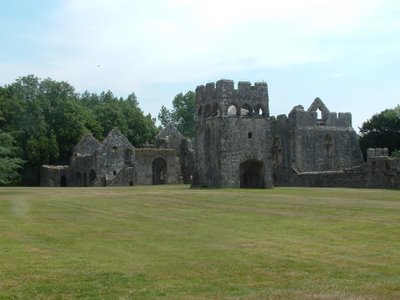
Manorbier castle, three kilometres south-east of Lamphey, is interesting in that it was the birthplace and home of a Gerallt Gymro (1146-1223). This scholar and churchman influenced through his work and writing the way people looked at Wales for centuries.
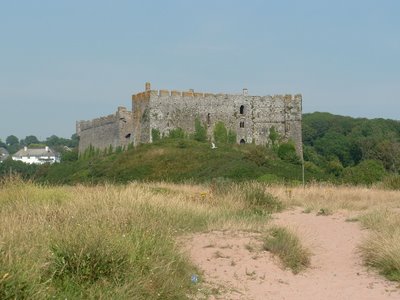 We travelled on from Manorbier and stayed at the Wiseman's Bridge Inn in Wiseman's Bridge just down the coast from Saundersfoot. The Inn lies on the edge of Amroth Bay and our bedroom window overlooked the waves lapping on the rocks below - idyllic. No doubt the chef tried very hard but the chicken with almond sauce just didn't work! Otherwise, it was a very pleasant stay.
We travelled on from Manorbier and stayed at the Wiseman's Bridge Inn in Wiseman's Bridge just down the coast from Saundersfoot. The Inn lies on the edge of Amroth Bay and our bedroom window overlooked the waves lapping on the rocks below - idyllic. No doubt the chef tried very hard but the chicken with almond sauce just didn't work! Otherwise, it was a very pleasant stay.
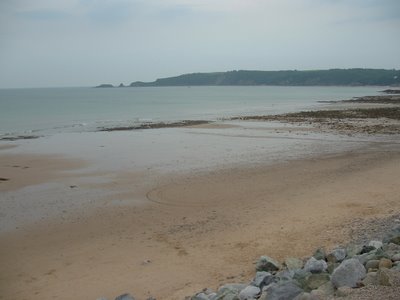
The following day was grey and misty and we made our way back home through the Brecon Beacons. We eventually joined the A470 and stopped off at the Beacons National Park Mountain Centre near Libanus. Though the day had brightened the stunning views of Pen-Y-Fan were not visible owing to low cloud but excellent exhibitions and displays more than made up for it as well as the tea and bara brith (a Welsh delicacy) that we enjoyed from the "Taste of Wales" menu in the restaurant.
We could not pass Hay-on-Wye without stopping. It is one of our favourite places and since we managed to get accommodation in The Old Black Lion we decide to stay the night. That night's dinner in the hotel was excellent and since the weather had cleared up we went for a short walk down to the river.
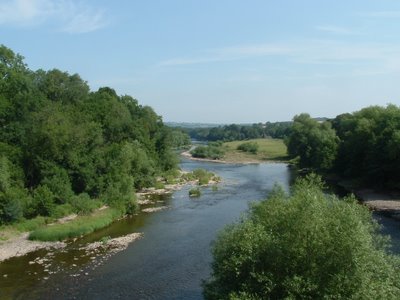 The main fascination for us in Hay is the bookshops and we couldn't resist spending the following morning before returning home in their exploration.
The main fascination for us in Hay is the bookshops and we couldn't resist spending the following morning before returning home in their exploration.
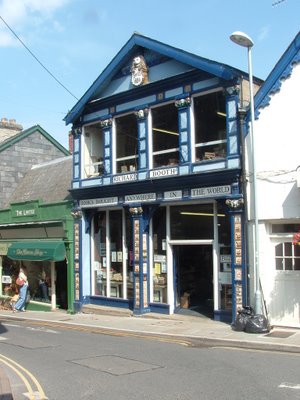
It is rather odd that there is no Welsh book shop in Hay and maybe there is an opening there for a Prytherch-Williams empire that might one day match the legendary Booth's.
****************
